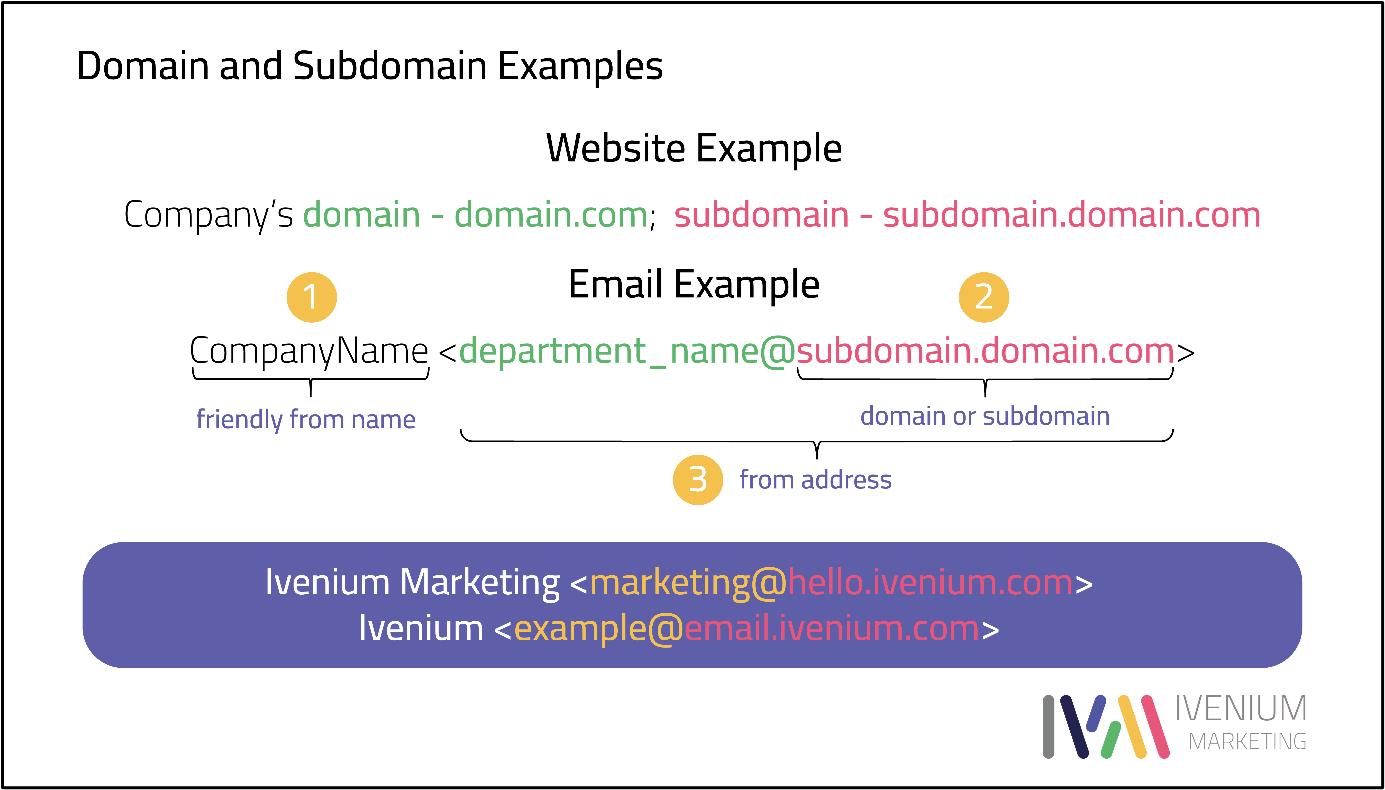Good practices: Why sharing the same sub-domains for traffic and bounceback is not a good idea.

Domains and subdomains are vital for your business’ online presence. Implemented, and later maintained well, they can improve your sites’ reputation as well as email deliverability. Yet some organizations decide to use the same domain both as a landing page and a bounceback domain. It’s a risky move that can cause severe damage to your marketing efforts. Let’s see how to properly manage your subdomains and get the best out of them.
Domain and subdomain — what’s the difference
It’s always good to start at the beginning. In that case, it’s the domain and subdomain. Both these terms are intertwined, yet there are some differences we must address.
A domain name is the named address of your company’s website. The domain name is what comes after the @ in an email address or the name of the company’s website. A domain is essentially a placeholder for an IP address. Before we used domains, people had to type out the entire IP address to reach a website.
IP address is a series of numbers… However, it’s hard to remember numbers, especially long ones. That’s why we use domain names. The domains are stored in a database of Domain Names System (DNS).
Subdomain meanwhile is the subset of the domain. You know addresses like mail.google.com, www.google.com, and docs.google.com, right? Well, they are all subdomains of the domain google.com. Domain owners can create subdomains to provide easy-to-remember addresses for web pages or services within their top-level domain.
Did you know?
In 2021, there were an estimated 367 million “claimed” domain names (purchased and owned through a registrar)
Deliverability and DNS problems
When you configure the DNS record for the root of each sub-domain you can also use these sub-domains for landing pages. The biggest DNS problem for email deliverability is in the CNAME record at the top of the domain. CNAME is very important, as it records and links the parent domain to its alias or subdomains. You can have a CNAME for any subdomain, but it’s not allowed to have it on top of the domain.
CNAME vs. A Records
CNAME is not the only type of record available. The second one, A record, can only connect the primary parent domain to the corresponding IP address. Which means that CNAME records linked with alias or subdomains can point to other CNAME records or A records but A records can only point to the IP address of a domain.
Importantly, a parent domain can only have an A record, not a CNAME record. Because the IP address found within a subdomain may change without notice, it is strongly recommended that all clients, whenever possible, use the CNAME record and not the A Record.
Domain and subdomain — examples
This illustration presents the key differences between domain and subdomain for websites and within emails:

Website example is simple — you have your company’s domain, and then subdomains, that can refer to different aspects of your business. They are important for your SEO and visibility in search engines.
Email subdomains are a little bit different. They are always related to your root domain, yet they have separate IP addresses. Meaning that ISPs and mailing servers see it as a separate element from your company’s domain. Subdomains are also crucial to building your reputation — the better it is, the bigger chance more people will read your emails. Also, in case of a situation when your subdomain is marked as spam and will lose reputation, it doesn’t affect other addresses. Meaning you can ditch the subdomains that perform poorly with no value lost.
Why do you need subdomains?
The advantage we described earlier is the core benefit for your subdomains, as they need to be used for email deliverability.
Email reputation relies on the domain or the subdomain. ISPs determine if the email will be placed in the inbox, trash, spam or promotions folders. Using a subdomain allows you to differentiate yourself from other departments’ sending practices, as subdomains have separate reputations. So, the bad email practices of another team at the same company that shares a domain from a company level will not be counterproductive to your entire team’s efforts. Over time, the ISPs will recognize and trust your sending subdomain. Branded sub-domains are an opportunity to strengthen your brand recognition with your recipients. It is important to select a branded subdomain that reinforces your brand identity, and it should be easily associated with your brand.
Domain and Subdomain — best practices and one warning
1.Email authentication is a must — it’s crucial for your company to avoid cybersecurity threats and validate your identity. There are three standards to authenticate your mail:
Sender Policy Framework (SPF) — helps validate outbound email sent from your custom domain.
DomainKeys Identified Mail (DKIM) — lets you add a digital signature to outbound email messages in the message header.
Domain-based Message Authentication, Reporting, and Conformance (DMARC) — ensures the destination email systems trust messages sent from your domain.
2. Send high-quality messages — get to the point, don’t use too many graphic elements (consider HTML-only options), and use proper Call-To-Action.
3. Warm your inbox — set a proper content calendar. Send a reasonable number of emails at regular intervals. Flooding recipients’ inboxes occasionally, with no rhyme or reason, can hurt your subdomain’s reputation badly.
4. Establish, monitor, and maintain your domain’s reputation — you can use an online tool to check how your domain (and, overall, online presence) is perceived. This way you can promptly react to potential reputation loss and adjust your campaign strategy for better results.
5. Use many different subdomains* — you can create different subdomains targeted to different groups. This helps you keep track of different campaigns and protects your main domain reputation. In case of spam reporting, only this specific subdomain will suffer reputation loss, instead of the whole ecosystem.
*However, this method has its downsides. You must establish and maintain a domain’s reputation and send a proper number of messages from many domains to keep its index relatively high. Sounds easy, but in reality, it may be impossible to execute it properly with automation tools (not to mention hand-in maintenance). Due to that reason, as Ivenium, we don’t recommend using this method, due to its time-consuming aspect.
The more you know…
Bounceback — electronic mail that is returned to the sender because it cannot be delivered for some reason. It usually appears as a new note in your inbox. E-mail users can encounter bounce e-mail because an addressee has changed his or her address, because their mailbox is full, because the note is misaddressed, or for some other reason.
Domains, bouncebacks and marketing automation
If you scale your business up, you can’t rely on setting email campaigns manually. It’s too time- and resource-consuming. That’s where marketing automation solutions come in. One of the most popular and reliable solutions is Oracle’s Eloqua, a tool designed for B2B Marketing Automation.
During configuration, you can choose a number of subdomains to be used for the bounceback address in emails sent to Eloqua. The subdomains should be unique to Eloqua and will be leveraged for bounceback handling and reporting in Eloqua. At the same time, you can use the same subdomains to publish landing pages in Eloqua.
Recommendations for sub-domain creation:
- If your company’s domain is company.com, create a sub-domain of example.company.com.
- Create sub-domains that are specific to your company or industry. For example, because Eloqua is a leader in demand generation, they use the subdomain demand.eloqua.com.
- Avoid using “email”, “sales”, or “marketing” as the sub-domain or bounceback domain, because that may subject your communications to more scanning by the receiving ISPs.
- Subdomains shouldn’t have been previously used.
Eloqua Branding and Deliverability package supports 3 sub-domains for the standard service, and up to 20 for enterprise and premium users.
Landing Page and Bouncebacks — what’s the problem?
Usually bounceback subdomain is created to gather information about mailing deliverability and inform about potential problems with it. Some companies decide to use the same subdomain for Landing Page and bounceback at the same time. It’s not a good idea.
As Ivenium, we reported problems our clients had, when they decided to use that solution. They mostly revolve around the sudden shut of their microsites, as the IP addresses are the same. Oracle sees it as a problem and shuts the subdomain down. Leaving you with many problems. But if you manage to update your IP address, it can be avoided — as long as you do that before Oracle updates the address.
It’s important to note that Eloqua is moving to Oracle Cloud Infrastructure (OCI). The customers may need to make some DNS configuration changes between Jan 16 – Mar 10, 2023, the company states (full timeline and FAQ can be found here). The most important change is that those who currently use an A record must update their DNS to use a CNAME record instead. But what if my web traffic subdomain is also used as a bounceback?
If you must use the A Record to point the subdomain to Eloqua:
1. Navigate to http://www.dnsgoodies.com/ (or similar DNS query site)
2. Under DNS Query Lookup:
- Enter the following: s[site ID].hs.eloqua.com
- Replace [site ID] with the site ID of your instance (without the square brackets)
- To find the site ID of your instance, log in to Eloqua > Open a new browser tab and use the following URL: https://login.eloqua.com/id. This will open a page that contains the following details: “site”: “id”:<your site ID will be here>
- Click DNS Lookup
3. Within the A Record result, there will be an IP address which is the one to input into the A Record of the domain.
This way your online presence, and data gathering, remain stable and reliable. Subdomains are easily created, and diversifying them can help with many things. And if you can’t do this in-house, Ivenium is happy to help. Contact our sales representative or leave us a message. We will contact you shortly and think of the best solution to maximize the benefits of your marketing campaigns and strategies.
